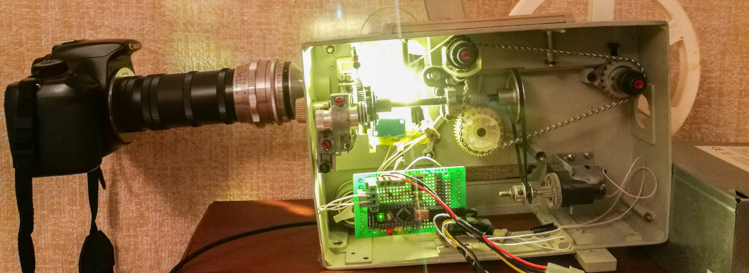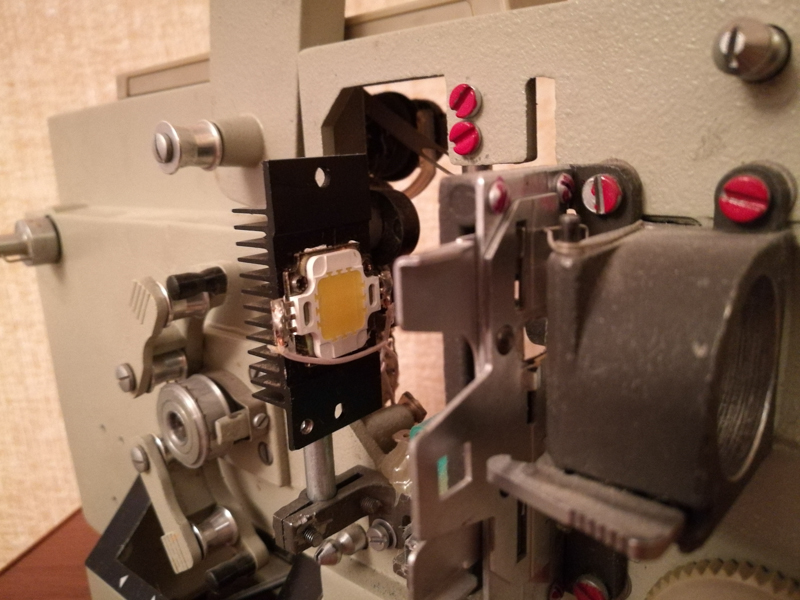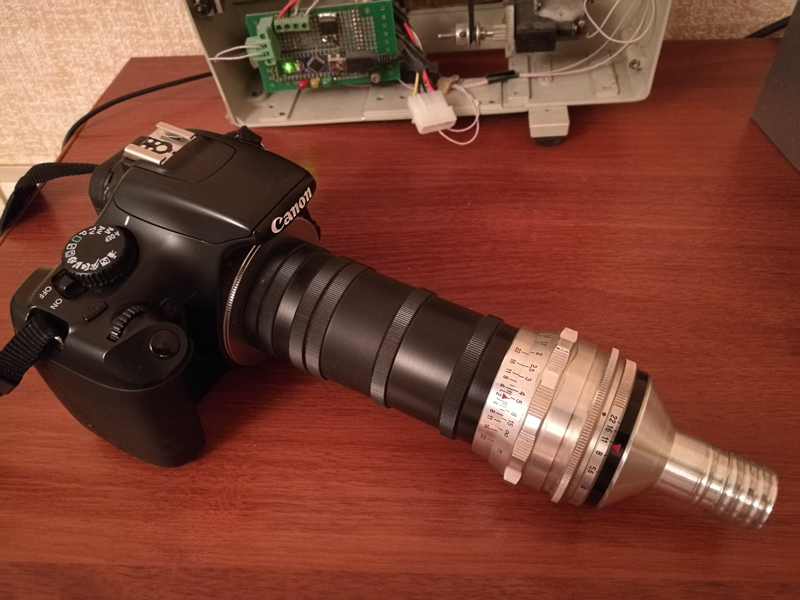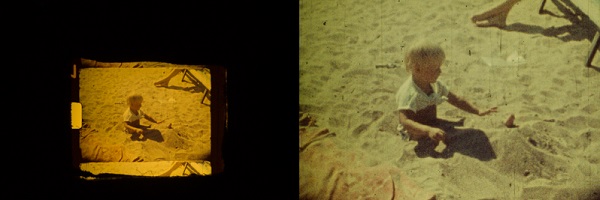Self-digitization of 8 mm film
Having found several reels with a “8 Super” format film in the bins of the cabinet, I realized that it was time to save and digitize them long ago, the dates of the films shooting were 89-92 years of the last century. On the study of the endangered market, cost, manufacturing in the article and will be discussed. Under the cut photo and video process.

The condition of the films was very different, color films were preserved much better than black and white ones. But, in any case, the degradation was evident - fading, some films began to peel.
Initially, I planned to pay for the digitization of the film and thus resolve the issue, but when I studied the market I realized that it would be a failure option. I had about 120 minutes of films (8 reels for about 15 minutes). On average, this is 10 tr. and not very dependent on the city. It seems acceptable for a family archive, memory is more expensive, but when specifying details it turned out that there was no more specialized equipment, or it was not. Self-made decisions, even with statements on the site about frame-by-frame shooting (more about the technologies below), were made on a video camera, which, given the current state of some films, was too presumptuous by the final quality.
There were 3 main methods of digitization:
As you can see from the first photo I decided to go 3 ways.
The final version of the algorithm is very simple:
- the shooting team is transferred to the camera;
- the camera takes a picture and throws it off on the PC;
- the film is rolled on one frame;
- the cycle repeats.
In my implementation there are small nuances, but about them later.
For clarity, I will immediately show the video of the work:
Everything is based on the Rus projector, which is popular for digitizing. The main advantage is the availability and the ability to choose the drum of two film formats 8mm and "8 super." The second has reduced perforation and due to this, the frame area has been increased by more than 30%. In addition to this, I just had a projector.
Of the improvements:
- Cleaned the obturator;
- Replaced the motor, since the standard can not be PWM adjustment at low speeds;
- the lamp was replaced with a 9-segment LED matrix (on top of it secured a sheet of paper for uniform illumination). Radiator LED took a very old, buggy video card.

The camera chosen is far from the most optimal, but it was the cheapest option that I could find. Canon 1100D, the youngest model, able to fully work with the Canon SDK. The guaranteed resource of its shutter is more than 100,000 frames, I have about the same number of frames, and the camera got almost new. Of course, a camera without a mirror would be much better here, but it would cost much more, and the whole project would still be cheaper than the cost of commercial digitization.
Some readers probably wondered why this monstrous design:

Everything rests on the focal length and frame size on the matrix. There is an option using two lenses, when the second is counter-deployed, but in my opinion two sets of glasses are worse than one in this case. One more adapter is required, and again I had rings, but the same second lens did not. The length of the rings - 100mm. The only detail that I could not make myself or buy ready is the adapter from the lens to the projector mount. She was carved to me by the guys with whom we participated in the Battle of Robots in Sochi . By the way, this design allows you to take such pictures (grain buckwheat):

Having received a bunch of files with numbers in ascending order, it is very convenient to batch them in Lightroom. I only changed the settings when changing the shooting conditions, in fact, for 15 minutes of cinema, there were no more than 10 changes. At this stage, a bonus from RAW is affecting, since you can draw out films that are almost not visible on the screen. Here you can stick for a long time - a question of approach, I didn’t remove scratches and so on, the film still. Further, all processed frames are thrown into the video editor and in general, that's all.
Frame before batch processing and after:

On software, everything is simple, it took no more than an hour with regard to the search. For the Canon SDK, there is an excellent EDSDKLib shell, added a virtual COM port to its work. The command to make a frame - there, back we are waiting for the command about successful rewinding. The only caveat that for some reason the camera sometimes remained in the mode of resetting files to the PC was decided by adding the delay after the shooting.
The program for Atmega is written in AVR Studio, gives out PWM to the rewind engine until the mechanical limit switch works. According to the mind, it had to be made optical, since it lasts for 40,000 maximum actuations, but the process was already underway and I did not redo it.
The final result (this is not the most optimum for what was / has become, but by many recognizable place - Peterhof and its fountains in 1990, and not the summer cottage series):
The final quality, of course, strongly depends on the initial state of the film, but in any case it is possible to recover and, most importantly, save a part of the family history.

The condition of the films was very different, color films were preserved much better than black and white ones. But, in any case, the degradation was evident - fading, some films began to peel.
Initially, I planned to pay for the digitization of the film and thus resolve the issue, but when I studied the market I realized that it would be a failure option. I had about 120 minutes of films (8 reels for about 15 minutes). On average, this is 10 tr. and not very dependent on the city. It seems acceptable for a family archive, memory is more expensive, but when specifying details it turned out that there was no more specialized equipment, or it was not. Self-made decisions, even with statements on the site about frame-by-frame shooting (more about the technologies below), were made on a video camera, which, given the current state of some films, was too presumptuous by the final quality.
There were 3 main methods of digitization:
- Shooting on a video camera from the screen. Even with the ideal quality of the source material, a very degraded copy is obtained.
- Lens in the lens. Basically, they offer to shoot again with a video camera, they call it time-lapse shooting, but in fact using the program (which, by the way, is publicly available), they throw out repeated frames and their change. The quality is better, but since editing is poor, the original state should be appropriate.
- Honest time-lapse shooting. Since the speed in this process has no effect, it allows you to shoot in RAW formats. Commercially, this option is now for some reason no one offers (or I did not find it).
As you can see from the first photo I decided to go 3 ways.
The final version of the algorithm is very simple:
- the shooting team is transferred to the camera;
- the camera takes a picture and throws it off on the PC;
- the film is rolled on one frame;
- the cycle repeats.
In my implementation there are small nuances, but about them later.
For clarity, I will immediately show the video of the work:
Everything is based on the Rus projector, which is popular for digitizing. The main advantage is the availability and the ability to choose the drum of two film formats 8mm and "8 super." The second has reduced perforation and due to this, the frame area has been increased by more than 30%. In addition to this, I just had a projector.
Of the improvements:
- Cleaned the obturator;
- Replaced the motor, since the standard can not be PWM adjustment at low speeds;
- the lamp was replaced with a 9-segment LED matrix (on top of it secured a sheet of paper for uniform illumination). Radiator LED took a very old, buggy video card.

The camera chosen is far from the most optimal, but it was the cheapest option that I could find. Canon 1100D, the youngest model, able to fully work with the Canon SDK. The guaranteed resource of its shutter is more than 100,000 frames, I have about the same number of frames, and the camera got almost new. Of course, a camera without a mirror would be much better here, but it would cost much more, and the whole project would still be cheaper than the cost of commercial digitization.
Some readers probably wondered why this monstrous design:

Everything rests on the focal length and frame size on the matrix. There is an option using two lenses, when the second is counter-deployed, but in my opinion two sets of glasses are worse than one in this case. One more adapter is required, and again I had rings, but the same second lens did not. The length of the rings - 100mm. The only detail that I could not make myself or buy ready is the adapter from the lens to the projector mount. She was carved to me by the guys with whom we participated in the Battle of Robots in Sochi . By the way, this design allows you to take such pictures (grain buckwheat):

Having received a bunch of files with numbers in ascending order, it is very convenient to batch them in Lightroom. I only changed the settings when changing the shooting conditions, in fact, for 15 minutes of cinema, there were no more than 10 changes. At this stage, a bonus from RAW is affecting, since you can draw out films that are almost not visible on the screen. Here you can stick for a long time - a question of approach, I didn’t remove scratches and so on, the film still. Further, all processed frames are thrown into the video editor and in general, that's all.
Frame before batch processing and after:

On software, everything is simple, it took no more than an hour with regard to the search. For the Canon SDK, there is an excellent EDSDKLib shell, added a virtual COM port to its work. The command to make a frame - there, back we are waiting for the command about successful rewinding. The only caveat that for some reason the camera sometimes remained in the mode of resetting files to the PC was decided by adding the delay after the shooting.
The program for Atmega is written in AVR Studio, gives out PWM to the rewind engine until the mechanical limit switch works. According to the mind, it had to be made optical, since it lasts for 40,000 maximum actuations, but the process was already underway and I did not redo it.
The final result (this is not the most optimum for what was / has become, but by many recognizable place - Peterhof and its fountains in 1990, and not the summer cottage series):
The final quality, of course, strongly depends on the initial state of the film, but in any case it is possible to recover and, most importantly, save a part of the family history.
